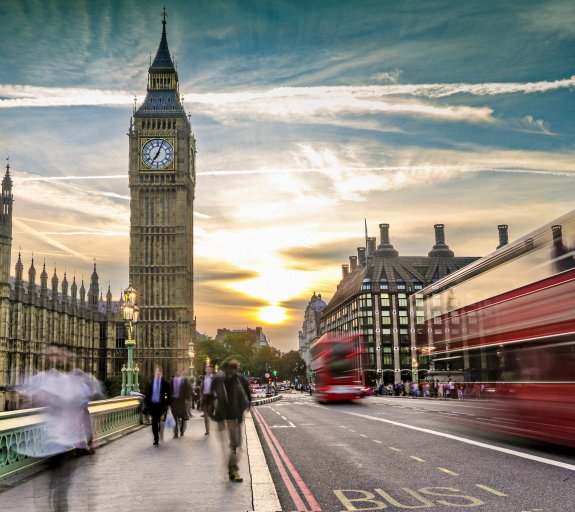
UK reaction: UK exits recession with better-than-expected GDP growth
- 10 Mayo 2024 (3 min de lectura)
KEY POINTS
The UK economy has rebounded strongly from last year’s recession, as rising real incomes encouraged households to increase spending and industrial production began to recover. Indeed, March’s 0.4% GDP increase drove a stronger-than-expected 0.6% quarter-on-quarter in the first quarter (Q1). Forecasters had expected a smaller 0.4% rise, after declines of 0.1% and 0.3% in Q3 and Q4 2023, respectively. Growth beat the Bank of England (BoE) Monetary Policy Committee’s upgraded forecast of 0.4% quarter-on-quarter and now looks set to outperform the BoE’s forecasts for the year. It is important to remember that this is a first estimate and therefore is subject to revisions, but GDP now looks set to increase by 0.6% this year, compared to our previous forecast, and the BoE’s, of 0.4%.
The stronger-than-expected monthly increase was largely driven by a 0.5% rise in services output, with 10 of the 14 subsectors growing in March. Consumer-facing services saw growth of 0.7%, following a 0.1% fall in February, as households switched spending towards food activities and accommodation. Production also increased on the month, driven by a 0.3% recovery in manufacturing output. The bumpy recovery in the manufacturing Purchasing Managers’ Index in recent months suggests this should broadly continue over the next few months. Construction, however, continued to fall, due to a decline in new work and repair and maintenance, as elevated borrowing costs continued to weigh on the sector.
Looking at the expenditure breakdown, the recovery in households’ consumption was a key driver, likely supported by the ongoing recovery in real incomes; it rose by 0.2% quarter-on-quarter after two consecutive quarters of decline. The recovery was broad-based, with households ramping up spending in most areas, including on housing, water and fuels. Overall, consumer-facing services grew by 0.6% in Q1, driven by retail sales, despite the wet weather. Strike action, meanwhile, continued to influence government spending. Junior doctors did not strike in March, following a five-day walkout in February, spurring a 1.1% monthly rebound in human health and social work activities. As a result, government expenditure rose by a further 0.3% in Q1, after a 0.1% rise in the previous quarter. Finally, gross fixed capital formation rose by 1.4% quarter-on-quarter, reflecting a 0.9% increase in real business investment.
A further recovery in real incomes - as pay growth continues to outpace CPI inflation and tax and benefit changes filter through – alongside rising confidence, falling interest rates and a fading mortgage hit, should support further increases in household consumption over the coming months. Today’s data also imply the household saving ratio edged down in Q1, given that nominal expenditure increased by 0.6% quarter-on-quarter, but employees’ compensation rose by a smaller 0.2%. While we don’t see a sharp drop, a further tick down will also support consumption.
Business investment, however, will likely hold broadly steady over the remainder of the year. Firms’ balance sheets are in pretty good shape but elevated borrowing costs will continue to make some projects unprofitable and businesses will probably want to wait to see the results of the General Election before going ahead. Overall, the strong start to the year means we have revised up our 2024 GDP forecast to 0.6% this year. Markets reacted modestly to the data, with sterling rising by 0.03% to $1.2536.
Disclaimer
Este documento tiene fines informativos y su contenido no constituye asesoramiento financiero sobre instrumentos financieros de conformidad con la MiFID (Directiva 2014/65 / UE), recomendación, oferta o solicitud para comprar o vender instrumentos financieros o participación en estrategias comerciales por AXA Investment Managers Paris, S.A. o sus filiales.
Las opiniones, estimaciones y previsiones aquí incluidas son el resultado de análisis subjetivos y pueden ser modificados sin previo aviso. No hay garantía de que los pronósticos se materialicen.
La información sobre terceros se proporciona únicamente con fines informativos. Los datos, análisis, previsiones y demás información contenida en este documento se proporcionan sobre la base de la información que conocemos en el momento de su elaboración. Aunque se han tomado todas las precauciones posibles, no se ofrece ninguna garantía (ni AXA Investment Managers Paris, S.A. asume ninguna responsabilidad) en cuanto a la precisión, la fiabilidad presente y futura o la integridad de la información contenida en este documento. La decisión de confiar en la información presentada aquí queda a discreción del destinatario. Antes de invertir, es una buena práctica ponerse en contacto con su asesor de confianza para identificar las soluciones más adecuadas a sus necesidades de inversión. La inversión en cualquier fondo gestionado o distribuido por AXA Investment Managers Paris, S.A. o sus empresas filiales se acepta únicamente si proviene de inversores que cumplan con los requisitos de conformidad con el folleto y documentación legal relacionada.
Usted asume el riesgo de la utilización de la información incluida en este documento. La información incluida en este documento se pone a disposición exclusiva del destinatario para su uso interno, quedando terminantemente prohibida cualquier distribución o reproducción, parcial o completa por cualquier medio de este material sin el consentimiento previo por escrito de AXA Investment Managers Paris, S.A.
La información aquí contenida está dirigida únicamente a clientes profesionales tal como se establece en los artículos 194 y 196 de la Ley 6/2023, de 17 de marzo, de los Mercados de Valores y de los Servicios de Inversión.
Queda prohibida cualquier reproducción, total o parcial, de la información contenida en este documento.
Por AXA Investment Managers Paris, S.A., sociedad de derecho francés con domicilio social en Tour Majunga, 6 place de la Pyramide, 92800 Puteaux, inscrita en el Registro Mercantil de Nanterre con el número 393 051 826. En otras jurisdicciones, el documento es publicado por sociedades filiales y/o sucursales de AXA Investment Managers Paris, S.A. en sus respectivos países.
Este documento ha sido distribuido por AXA Investment Managers Paris, S.A., Sucursal en España, inscrita en el registro de sucursales de sociedades gestoras del EEE de la CNMV con el número 38 y con domicilio en Paseo de la Castellana 93, Planta 6 - 28046 Madrid (Madrid).
© AXA Investment Managers Paris, S.A. 2024. Todos los derechos reservados.
Advertencia sobre riesgos
El valor de las inversiones y las rentas derivadas de ellas pueden disminuir o aumentar y es posible que los inversores no recuperen la cantidad invertida originalmente.





